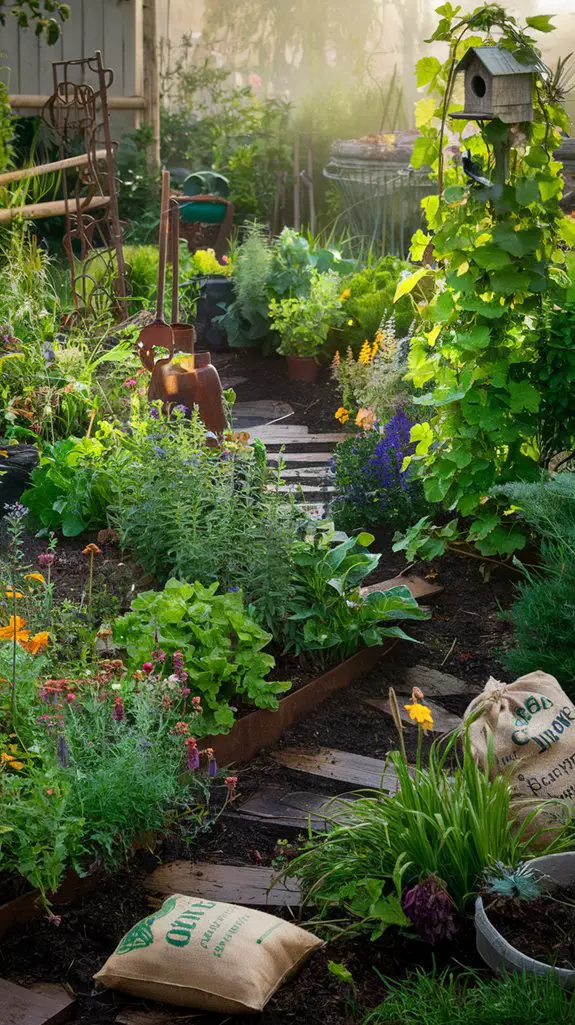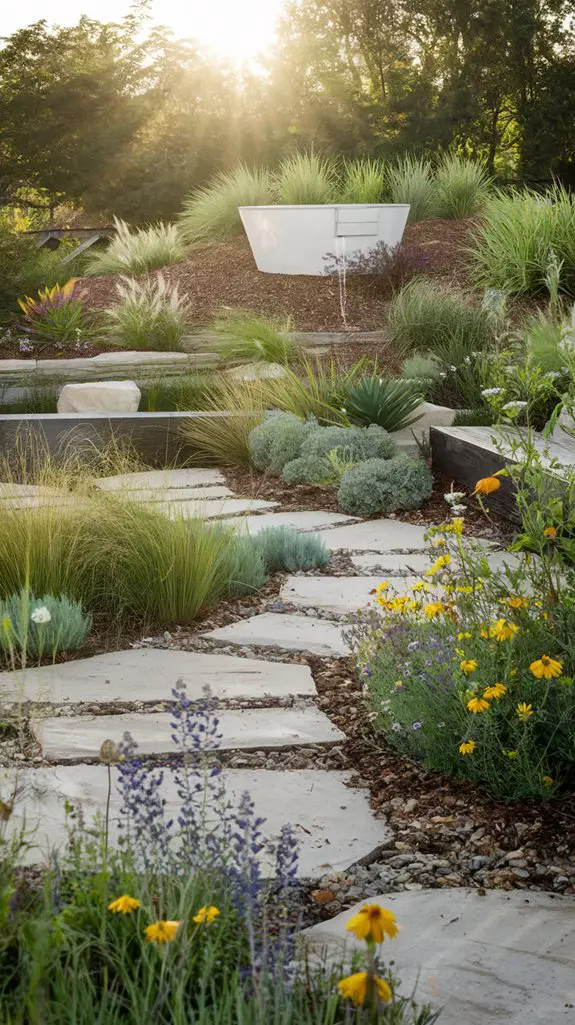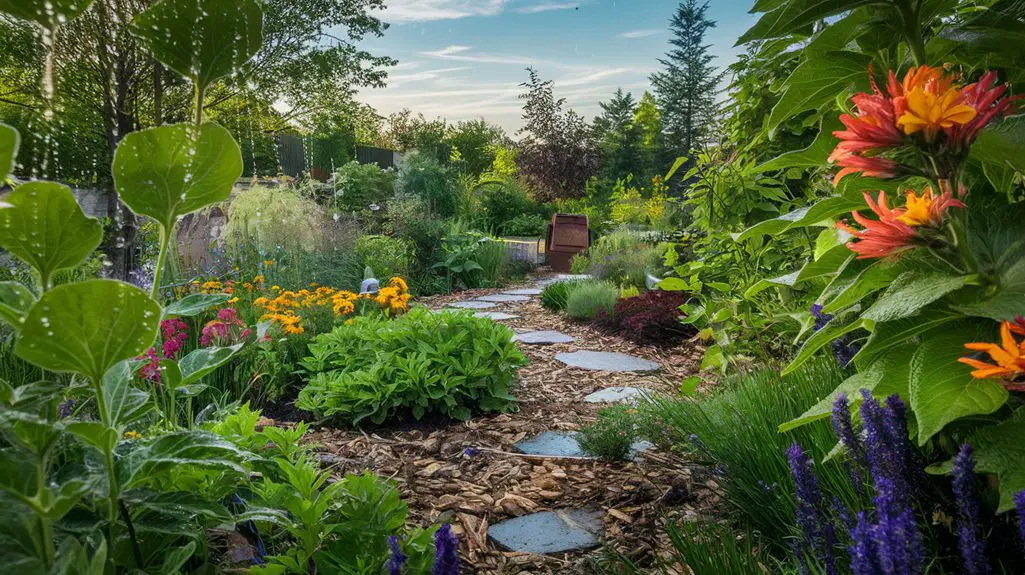Your garden can be a thriving ecosystem, much like a symphony where every plant plays its part in harmony. By choosing native species and implementing sustainable practices, you can create a landscape that not only flourishes but also supports local wildlife. From rain gardens to organic soil amendments, the possibilities are vast. So, how do you start transforming your outdoor space into an eco-friendly haven? Let's explore the essential steps together.
Choosing Native Plants for Your Garden
Why choose native plants for your garden?
They're perfectly adapted to your local climate and soil, ensuring they thrive with minimal maintenance. By selecting native species, you'll support local wildlife, providing essential habitats for pollinators like bees and butterflies.
These plants require less water and fewer chemicals, reducing your garden's environmental impact. Plus, their deep-root systems improve soil health and prevent erosion, contributing to a resilient ecosystem.
You'll enjoy vibrant blooms and diverse textures, all while conserving resources. Embracing native plants transforms your garden into a sustainable haven that harmonizes with nature.
Implementing Rain Gardens for Stormwater Management
As you seek to enhance your garden's sustainability, implementing a rain garden can be a game-changer for stormwater management.
Start by selecting a low-lying area in your yard that naturally collects water. Dig a shallow depression and amend the soil with organic matter to promote drainage.
Next, choose native plants that thrive in wet conditions—these will absorb excess water while filtering pollutants. Arrange your plants in clusters for visual appeal and better water uptake.
During rain events, your rain garden will capture runoff, reducing erosion and preventing flooding.
Don't forget to mulch around your plants to retain moisture and suppress weeds.
With thoughtful design, your rain garden will become a vibrant ecosystem, benefiting both your landscape and the environment.
Utilizing Organic Soil Amendments

When you enrich your garden with organic soil amendments, you're not just boosting plant health; you're fostering a vibrant ecosystem. Organic matter like compost, aged manure, and worm castings improve soil structure, enhance moisture retention, and promote beneficial microbial life.
Mixing these amendments into your soil creates a nutrient-rich environment where plants can thrive.
To use them effectively, incorporate a few inches of compost into the top layer of your soil before planting. Regularly add organic matter during the growing season to replenish nutrients and support soil biology.
You'll notice stronger plants, better yields, and reduced reliance on synthetic fertilizers. Plus, you're contributing to a sustainable cycle that nourishes both your garden and the planet.
Creating Pollinator-Friendly Spaces
Enhancing your garden with organic soil amendments sets the stage for a thriving ecosystem, but adding pollinator-friendly spaces takes your commitment to sustainability even further.
Start by planting a diverse array of native flowers, such as milkweed and coneflower, which attract bees, butterflies, and hummingbirds. Group plants in clusters to create easy access for pollinators. Avoid pesticides that can harm these essential creatures.
Incorporate water sources, like shallow dishes filled with pebbles, to provide hydration. Additionally, consider leaving some areas of your garden wild; this fosters natural habitats. Sustainable landscaping not only benefits pollinators but also enhances the overall biodiversity of your garden.
Planting flowering herbs, like lavender and thyme, not only beautifies your space but also serves as a food source.
With these simple steps, you'll cultivate a vibrant, pollinator-friendly oasis.
Designing With Xeriscaping Principles

How can you create a stunning landscape while conserving water? By embracing xeriscaping principles, you'll not only enhance your garden's beauty but also promote sustainability. Start by selecting drought-resistant plants that thrive in your climate. Group plants with similar water needs together to minimize waste. Incorporate mulch to retain moisture and reduce weeds. Additionally, consider using native plant landscaping to further support local ecosystems.
Here's a quick reference table to guide your xeriscaping journey:
| Plant Type | Water Needs | Ideal Conditions |
|---|---|---|
| Succulents | Low | Full sun |
| Native Grasses | Moderate | Partial shade |
| Perennials | Low to Moderate | Well-drained soil |
| Shrubs | Low | Sandy or loamy soil |
With these tips, you'll create an eco-friendly oasis!
Incorporating Edible Landscaping
As you transform your garden into a vibrant space, incorporating edible landscaping not only beautifies your outdoor area but also provides fresh produce right at your fingertips.
Start by selecting a mix of perennial herbs, fruits, and vegetables that thrive in your climate. Think beyond traditional rows; consider planting fruit trees as focal points or creating raised beds filled with colorful veggies.
Use companion planting to enhance growth and deter pests naturally. Incorporate edible flowers like nasturtiums and calendula, which add beauty and attract beneficial insects. Additionally, consider using backyard landscaping ideas that feature creative arrangements of edible plants to maximize both aesthetics and yield.
Layer your plants to maximize space and create visual interest. Remember, sustainable practices like organic fertilizers and composting will enrich your soil, ensuring your edible landscape flourishes while supporting local ecosystems.
Enjoy the bounty of your eco-friendly garden!
Installing Sustainable Irrigation Systems
While you cultivate your eco-friendly garden, installing sustainable irrigation systems can greatly reduce water waste and guarantee your plants thrive. Consider using drip irrigation, which delivers water directly to the roots, or rainwater harvesting systems that collect and store rainwater for later use. Both methods conserve water and promote healthier plants. Additionally, incorporating raised garden beds with drip irrigation can enhance your gardening efficiency and further minimize water usage.
Here's a quick comparison to help you choose:
| System Type | Benefits |
|---|---|
| Drip Irrigation | Reduces evaporation, direct delivery |
| Rainwater Harvesting | Lowers water costs, eco-friendly |
| Sprinkler Systems | Covers large areas quickly |
| Soaker Hoses | Simple installation, efficient |
| Smart Irrigation Controllers | Adjusts watering based on weather |
Using Recycled Materials in Hardscaping
Incorporating recycled materials into your hardscaping not only enhances the aesthetic appeal of your garden but also contributes to a more sustainable environment.
Consider using reclaimed bricks or stones for pathways and patios; they add character while reducing landfill waste. You can also repurpose old concrete by breaking it into smaller pieces for decorative borders or gravel substitutes.
If you're feeling creative, try using recycled glass for vibrant mosaic features or edging. Wood pallets can be transformed into rustic benches or planters, giving your space a unique touch. Additionally, building raised beds with recycled materials is a great way to combine functionality with eco-friendliness.
Attracting Beneficial Wildlife to Your Garden
Creating a garden that attracts beneficial wildlife can transform your outdoor space into a vibrant ecosystem.
Start by incorporating native plants, as they provide food and habitat for local species. Plant a variety of flowers, shrubs, and trees to create layers that appeal to different wildlife.
Consider adding water features like bird baths or small ponds, which offer essential hydration. Avoid chemical pesticides, opting instead for natural pest control methods like beneficial insects.
Create shelter with log piles, brush heaps, or birdhouses. Finally, make sure your garden has sunny spots and shaded areas to accommodate diverse wildlife needs.
Maintaining Your Eco-Friendly Landscape
As you nurture your eco-friendly landscape, effective maintenance guarantees it flourishes year after year.
To keep your garden thriving, focus on these sustainable practices:
- Mulching: Retain moisture and suppress weeds with organic materials.
- Composting: Enrich your soil using kitchen scraps and yard waste.
- Watering Wisely: Use drip irrigation or rain barrels to conserve water.
- Pruning: Shape your plants to enhance air circulation and prevent disease.
- Crop Rotation: Vary plant families to improve soil health and deter pests.
Additionally, consider implementing effective pest control methods for your raised garden beds to protect your plants naturally.
Conclusion
By nurturing your eco-friendly garden, you're crafting a vibrant tapestry of life, where every plant plays its part in nature's symphony. As you embrace sustainable practices, you'll watch your outdoor space flourish, drawing in pollinators like a magnet and transforming your landscape into a haven of biodiversity. So, roll up your sleeves, get dirt under your nails, and let your garden tell a story of harmony, resilience, and beauty—one leaf at a time.




